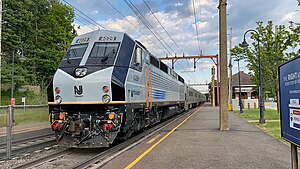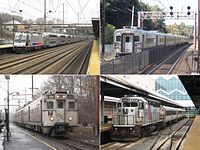
The GE Genesis is a series of passenger diesel locomotives built by GE Transportation for Amtrak, Metro-North, and Via Rail between 1992 and 2001. A total of 321 units were produced.

The Raritan Valley Line is a commuter rail service operated by New Jersey Transit (NJT) which serves passengers in municipalities in Union, Somerset, Middlesex, Essex and Hunterdon counties in the Raritan Valley region in central New Jersey, United States. The line's most frequent western terminus is Raritan station in Raritan. Some weekday trains continue farther west and terminate at the High Bridge station, located in High Bridge. Most eastbound trains terminate in Newark; passengers are able to transfer to NJ Transit using a combined ticket or PATH and Amtrak to New York City. A limited number of weekday trains continue directly to New York.
Vossloh AG is a rail technology company based in Werdohl in the state of North Rhine-Westphalia, Germany. The SDAX-listed group has achieved sales of around €930 million in 2016 and, as of 2017, had more than 4,000 employees.

The ABB ALP-44 was an electric locomotive which was built by Asea Brown Boveri of Sweden between 1989 and 1997 for the New Jersey Transit and SEPTA railway lines.

The passenger locomotives derivatives of the General Motors EMD GP40 diesel-electric locomotive have been, and continue to be, used by multiple passenger railroads in North America. For passenger service, the locomotives required extra components for providing steam or head-end power (HEP) for heating, lighting and electricity in passenger cars. Most of these passenger locomotives were rebuilt from older freight locomotives, while some were built as brand new models.
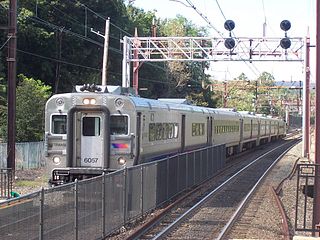
The Comet railcar is a class of locomotive-hauled railcars that was first designed in the late 1960s by Pullman-Standard as a modern commuter car for North American rail lines. Later, the Comet moniker was adopted by NJ Transit for all of its non-powered single level commuter coaches. Additional series of cars bearing the Comet name, based on the original design, have since been built by Bombardier Transportation and Alstom. The successful design was adopted by numerous commuter agencies.
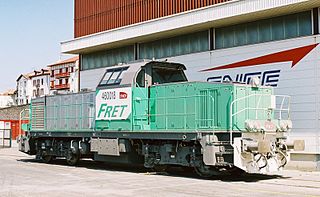
The SNCF Class BB 60000 are a class of 4 axle heavy shunting and light freight diesel–electric locomotives built at the Vossloh España works in Valencia. Since the class is primarily used as a freight locomotive the class is commonly referred to as SNCF BB 460000.

The Stadler Euro is a class of diesel-electric locomotives built by Stadler Rail for the European market. It is available in two basic variants, the four-axle Euro 3000, and the six-axle Euro 4000. These locomotives are powered by EMD 710 prime movers. A six-axle electric-only variant is marketed as Euro 6000; it is also built for the Iberian gauge.

The Prima Diesel-electric locomotives are a class of medium and heavy, four- and six-axle, passenger and freight mainline locomotives. They have been built both to 1,435 mm standard and 1,668 mm broad gauges, and find use in the Middle East, Europe and North America. Alstom is the primary designer in cooperation with both General Motors and Siemens.

The Renfe 334 is a high speed, 4 axle diesel-electric locomotive built to haul passenger trains on Renfe's Talgo service on non electrified lines.

The Eurorunner family of locomotives are a series of medium- to high-power diesel-electric locomotives built by Siemens for the European market. Introduced from 2002 onwards, they share design characteristics with the successful Eurosprinter range of electric locomotives, also built by Siemens.
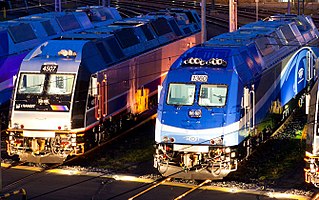
The Bombardier ALP-45DP is a type of single cab dual-mode locomotive operated by New Jersey Transit and Exo. The locomotive was designed and originally built by Bombardier until 2021, and by Alstom since 2021.
Stadler Rail Valencia SAU is a Spanish company, mainly producing products for the railway industry, subsidiary of Stadler Rail.

The MPI HSP46 is a four-axle AC-traction diesel-electric locomotive for commuter trains, designed and assembled by MotivePower. It meets EPA Tier 3 emissions standards. The launch customer is the Massachusetts Bay Transportation Authority (MBTA), whose first unit entered revenue service in April 2014.

The GA DE900 is a family of 4 axle Bo'Bo' diesel electric locomotives manufactured in Spain, by Meinfesa.

The Stadler Eurolight is the brand name for a family of 4-axle Bo'Bo' mainline diesel-electric locomotives with sub-20-tonne axleloads for passenger and freight trains produced by Stadler Rail.

The JT 42BW is a class of four axle Bo'Bo' diesel electric locomotives manufactured by Alstom's Meinfesa plant in Spain for Israel Railways (IR). The locomotives were the primary passenger locomotive unit used by IR through the 2000s.

The JT 42CW is a class of six axle Co'Co' diesel electric freight locomotives manufactured by Alstom's Meinfesa plant in Valencia Spain in the late 1990s for use by Israel Railways (IR).
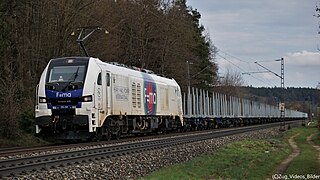
The Stadler EuroDual is a series of dual power, electro-diesel locomotive by Stadler Rail Valencia. Unlike traditional dual mode locomotives, fitted with relatively low-powered diesel engines for 'last mile' movements only, vehicles are typically furnished with power units more comparable to that of mainline diesel locomotives.

The Passenger Rail Agency of South Africa Class Afro 4000 of 2014 is a South African diesel-electric locomotive.
